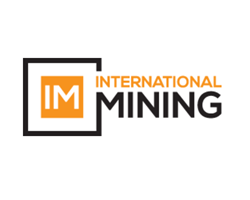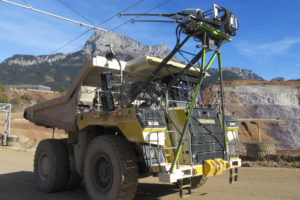Liebherr Outlines Mining Equipment Zero Emissions Roadmap Including Agnostic Power & Fuel Approach Ahead of MINExpo

By Paul Moore
September 12, 2021 - Liebherr says it is researching new technologies to make zero emissions mining a reality. But the company has already made significant progress – taking trolley assist as an example – all Liebherr trucks from 100 t payload upwards are equipped with an AC electric drive and are vailable with a trolley assist option. It is running the world’s largest 360 t (400 ton) class trolley assist truck fleet at FQM’s Cobre Panama. It was also the first global mining equipment OEM to run 100 t trucks with trolley assist at VA Erzberg iron ore mine in Austria which also now happens to have the longest trolley line in the world- around 5 km.
All of its mining excavators are already available with electric drive and cable management systems for shovel and backhoe configurations – with more than 60 units delivered and more than 30 years of experience. Based on this it offers operational concepts for electrical backhoe excavators in double benching operations. With electrification of digging and hauling machines supported by renewable energy mix off the grid, already field proven solutions do provide up to 80% GHG emission reduction. And last but not least, as of now, all Liebherr diesel engines in mining trucks and hydraulic excavators can operate with up to 100% Hydrogenated Vegetable Oil (HVO) as fuel. It said this underpins Liebherr’s determination of finding multiple solutions for decarbonisation with internal combustion engines.
Looking to the future, Liebherr says its future portfolio of solutions will be less electric grid dependent, providing more flexibility and will likely be based on a combination of technologies. “Flexibility is provided through on-board energy storage with the use of batteries or renewable fuels such as hydrogen or hydrogen-based derivate fuels (ammonia, methanol or more sophisticated E-fuels). The methanol combustion process has been developed and is ready to move towards serial engine industrialisation based on market demand. Hydrogen combustion engines are currently being tested in our factory in Switzerland. Once more sophisticated E-fuels become competitively available at large scale, Liebherr is ready to utilise these fuels in machines equipped with Liebherr engines. Liebherr sees a high potential in the usage of ammonia for heavy mobile, high energy demanding machines.”

Oliver Weiss, Executive Vice President R&D, Engineering and Manufacturing, Liebherr-Mining Equipment SAS outlined its strategy just ahead of the MINExpo 2021 event in Las Vegas.
Over the last 18 months, there has been a significant increase in demand for the decarbonisation of the mining industry. This has led to many mining companies announcing reduction targets for greenhouse gas emissions (GHG). How does this affect the activities of your business?
This further accelerated the implementation of already existing decarbonisation solutions, but it also created discussions and projects for potential future solutions. These commitments and initiatives are perfectly aligned with the values of Liebherr, a family owned company, as we consider it our responsibility to contribute to the decarbonisation of the mining industry. This shift in the market has validated Liebherr’s past accomplishments in mining equipment electrification with grid connection of the machines. It offers great opportunities for Liebherr to leverage the numerous in-house core competencies to deploy existing solutions while simultaneously developing future solutions.
How does Liebherr contribute to these changes in the mining industry? What are your targets?
Our targets are very ambitious and clear. If we look at the complete lifecycle of our machines from cradle to grave, we see that the operation phase of the machine is responsible for around 90% of the GHG emissions. This means that besides the efforts to reduce our carbon footprint across the entire business, our main focus is centered around the reduction of the GHG emissions of our machines in the operation phase. To address this, we have decided to go forward in two steps, immediate and medium-term solutions and initiatives. Firstly, we will offer low carbon emission solutions such as electric drive for all trucks and excavator types, trolley assist and cable reeler beginning in 2022. Additionally, the first renewable fuel option for the internal combustion engine drive train for machines with Liebherr combustions engines is available. And secondly, we will offer proven fossil fuel free mining equipment by 2030 at the latest. The equipment for digging, hauling and dozing will be based on different drive train technologies such as a battery power module, a H2 fuel cell power module and internal combustion engines with several further renewable fuel solutions depending on the equipment type.

What is your approach to define and design the right GHG emission neutral mining equipment and what are the drivers behind it?
Direct electrification offers the largest GHG emission reduction potential. It can also be achieved the fastest. Which is why we were focused on and are about to finalise grid electrification of our full range of haulage trucks and excavators. However, we also seek to provide solutions that can operate without fossil fuels. We attach high importance to comparing the GHG emissions over the full life cycle of the equipment. In addition, we are looking in detail at the overall well to wheel energy ecosystems. Only the full picture allows us to evaluate the true GHG emission impact. We also take into account the operational mining process conditions that influence the right energy type choice. We are energy type and drive train agnostic. As the Liebherr Group develops all of its technology in-house, we are free to develop the solutions that will provide the best value for our customers. The question for us is not necessarily which energy types are possible, rather which drive train possibilities are best suited in regards to environmental impact, safety, reliability, maintainability, as well as capital and operational expenditures in any given mine applications with their specific operational boundary conditions.
This seems to be a significant undertaking. How do you ensure that the targets are truly met by 2030?
The key point is to maintain dialogue and cooperation with our customers. We offer our customers access to our in-house knowledge and competence centres. Together with our customers, we defined the future operational conditions that will be considered while defining the system layouts and design of the future drive trains. Strategic partnerships are also crucial. They allow us to evaluate the well-to-wheel energy approach. At MINExpo 2021, we will announce two strategic partnerships: one, that will be an exciting accelerator for understanding all relevant aspects and advantages of green hydrogen and hydrogen based derivate fuels. And another, that will enable to consult our customers for the implementation of trolley assist infrastructure according their needs. In the last years, the Liebherr Group systematically increased the in-house core competencies of what we consider to be required to achieve the GHG emission reduction goals. To offer proven mining solutions by 2030, first fleet deployments for the mentioned potential solutions are targeted between 2024 and 2026.
You mentioned an opportunity to reduce GHG emissions with internal combustion engines, can you please explain in detail?
Yes, due to our significant research and development work on combustion engines, Liebherr has identified a huge potential for GHG emission reductions with internal combustion engines in combination with renewable fuels. They offer flexibility for the mines and represent a known and proven technology, with the advantage of established supply chains and full lifecycle management. For example, the Liebherr mobile crane division delivers all their mobile cranes filled with Hydrogenated Vegetable Oil (HVO) fuel. By approving HVO for the mining machines, Liebherr allows our mining customers to operate our machines while emitting 80-90% less well-to-wheel carbon emissions with no operational constraints and only limited additional cost. Customers could also benefit without moving to 100% HVO by using an HVO admixture for diesel fuel. The methanol combustion process has been developed for Liebherr’s large displacement engines and is ready to be translated into serial engine industrialisation, based on market appetite. An ammonia combustion process is under development. We are convinced of this potential. That is why from 2022 on, we will offer the option of a Liebherr engine for all of our ultra-class mining machines, which enables us in the future to use emerging renewable fuels. The modular engine design concept allows commercialisation of different engine versions that can use various renewable fuel types.
What challenges are mines facing in converting to electrification and future fossil fuel free solutions? How does Liebherr plan on helping them overcome those challenges?
The way of mining will change for most of the applications. Equipment powered by green energy will need different equipment utilisation and significant changes to the energy supply chain infrastructure ending at the machine. Furthermore, different regions will need different energy types due to the unique local generic cost of these energies. This will lead to a larger variation of equipment and a higher customisation of the machines. To anticipate this, Liebherr decided to stay application agnostic by offering a variety of exchangeable or complementary solutions. Trolley assist, for example, can be combined with trucks powered by battery, fuel cell, or combustion engines running on renewable fuel. This provides the best of both worlds: the cheapest green electric energy whenever possible and enhanced mobility. The initial investment can be a financial hurdle for mines to adopt new technology. Liebherr’s electrification solutions compensate the trolley infrastructure installation capital expenditure by creating a more productive truck fleet or even reduced truck fleet sizes due to significantly quicker speed on ramp. Electrified hydraulic excavators offer lower lifecycle costs. To support our customers in the mine setup, we offer cable handling systems with semi-automatic cable reelers and an operational concept in double benching.
How do the future zero emission drive train concepts influence the design of trucks and hydraulic excavators?
Due to the vast possible combinations of technology capable of delivering decarbonisation, we have taken the approach of modular design of the equipment and drive trains. This will allow power output adaptation and flexibility of technology selection. Furthermore, it is important to recognise that the future drive trains will have to be retrofittable. We are committed to supporting our customers through this journey, by providing solutions to upgrade recent machine models with future zero emission drive trains. For years, we have designed our hydraulic excavators following the modular concept to facilitate the upgrade from diesel to electric drive systems. This modularity is also very beneficial for the integration or retrofit of potential future renewable drive systems.
Everyone is talking about the future of drive trains. What about the machine itself? Is the current machine design offering important opportunities that could contribute to a transition to GHG emission reductions?
This is a very important question. And the answer is absolutely yes, there is potential. I give you two examples: Our large mining trucks have either a market leading payload or a market leading ratio of empty vehicle weight to payload. This is an important enabler of zero emission as it provides us the extra weight allowance to integrate, for example, trolley systems or battery power modules and still provide the payloads that customers need. Another example is the new R 9600 excavator with Liebherr Power Efficiency Control System and field proven 20% reduction in fuel consumption per hour. In combination with the productivity increase, this leads to 29 percent less fuel consumption per ton of produced material. The Liebherr Power Efficiency is already integrated in the excavator models R 9150, R 9200 now, in R 9800 by end of 2021 and will be introduced in the remaining machines in the next two to three years. For the previously mentioned machines, Liebherr also provides retrofit options to support customers to reduce GHG emissions (and costs) for already installed fleets. The reductions are within 5%, less in retrofit machines, but is still a significant improvement while the retrofit effort is minimal. We fulfil our responsibility to society and will contribute to the decarbonisation of the mining industry.

